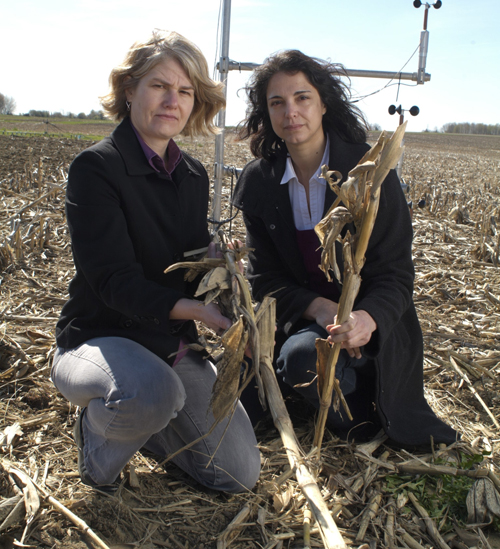
In a high-tech plant in Windsor, Ont., engineers ponder the thousands of parts that make up today’s fuel-efficient vehicle. They take every second of its life expectancy into account, from the time the minerals are blasted out of the earth, to the day the car is taken off the road and disassembled.
This detailed, piece-by-piece analysis is called life cycle analysis. It’s used to understand all of the inputs and outputs of a system over its entire production cycle.
In a project jointly supported by the OMAFRA – U of G partnership and the Ontario Corn Producers’ Association, Prof. Claudia Wagner-Riddle, School of Environmental Sciences, and Prof. Goretty Dias, University of Waterloo, are developing computer-modelling software for an on-farm life cycle analysis of biofuel crop production and greenhouse gas emissions.
An average corn crop, for example, has numerous inputs, including fertilizer, seeds and fuel. Each of these inputs has associated greenhouse gasses that are released during their production. But crops are also part of a complex biological cycle of both carbon and nitrogen; every tonne of nitrogen lost to the atmosphere as nitrous oxide is equivalent to 310 tonnes of CO2.
Because they’re so highly dependent on variable environmental conditions, weather and farm-management techniques, the life cycles of crop production are difficult to analyze. The development of accurate computer models promises to improve our understanding of the connections between agricultural production and the environment.
“This software model could be used by government to estimate and compare the impacts of biofuel policies at the farm level,” says Wagner-Riddle. This would fast-track the decision-making process associated with developing new biofuel production policies and bring new market opportunities to Ontario farmers sooner, she says.
These new opportunities could come in the form of carbon credits. A carbon credit is a theoretical unit equal to one ton of CO2. Credits are used within what’s called a cap-and-trade system where a maximum allowable emission rate or “cap” is determined, and credits are distributed. Carbon credits have the potential to reward farmers for the carbon sequestration services they may already be providing to society.
Determining how many credits a farm is producing and at what cost can be difficult to estimate, given the complexity and variability of farming. But computer models could help.
Wagner-Riddle’s research into the on-farm life cycles of three biofuel crops ─ corn, willow and switchgrass ─ is an effort to model the impact of management practices such as nitrogen application rate, as well as timing and placement of nitrogen, on the amount of nitrous oxides released from the system. The growth rate of the crop and the uptake of CO2, will also be calculated as important inputs of the life cycle analysis.
With a thorough understanding of the system from crop planting to end fuel use and accurate models of each step in between, policy could be developed to allow farmers growing biofuel feedstock in a sustainable way to gain carbon credits that could be sold as a secondary source of income.